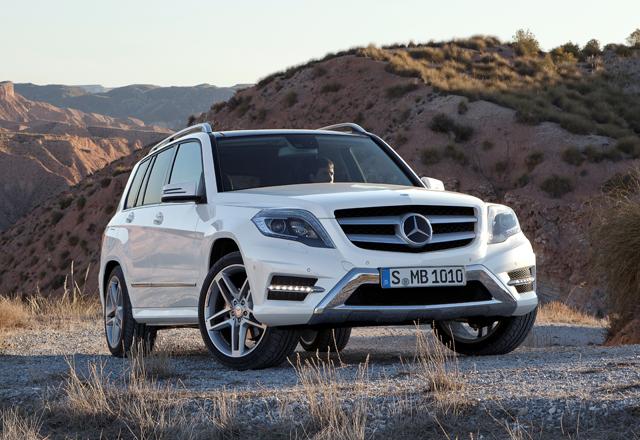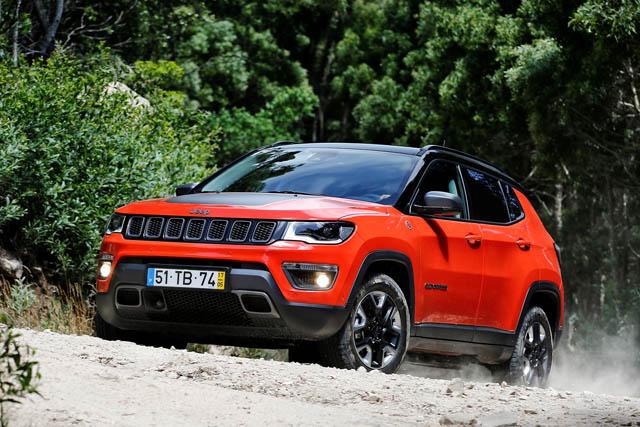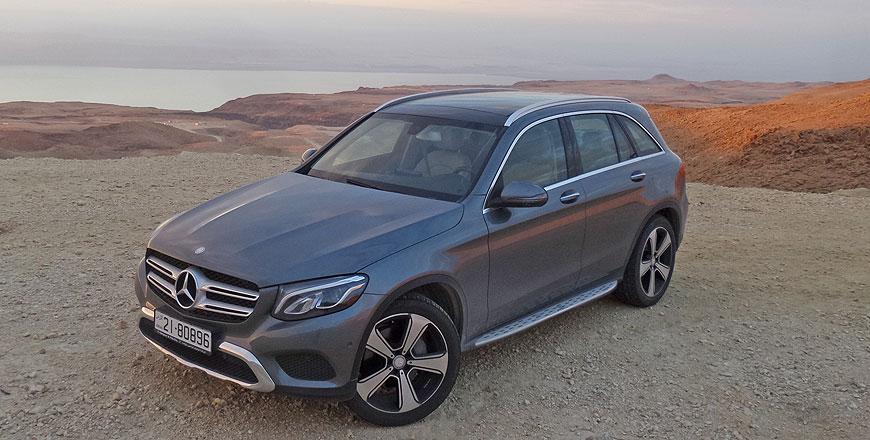You are here
All-round ability
By Ghaith Madadha - Mar 10,2014 - Last updated at Mar 10,2014

First launched in 2008 as Mercedes’ first gambit into then up and coming compact car-like SUV niche, the GLK Class put emphasis on a combination of practicality, on-road composure and modest but genuine off-road ability. The GLK Class may have lived somewhat in the shadow of the Mercedes’ larger and more established ML Class and it may not be as fashionably swept back and futuristic as the just released and smaller still GLA Class, but from this writer’s perspective, the GLK’s versatile and sensible appeal seems to have only grown, especially so after its 2012 midlife facelift and in GLK350 4Matic guise as recently driven.
Utilitarian design
Based on the outgoing Mercedes C Class saloon’s underpinnings and styled to look like a miniaturised version of Mercedes’ larger G Class and CL Class SUVs, the GLK Class’ upright body style is utilitarian if not trendy, while its long front end, wide stance and relatively low posture reflected its car-like on-road refinement and front-engine rear-drive based four-wheel-drive architecture. In fact, the GLK’s relatively low waistline and tall glasshouse may be contrary to prevailing fashion, but is one of its most practical features, in that it allows for excellent driving visibility to accurately place the car on road, and generous passenger headroom and cargo capacity.
Revised in 2012, the GLK’s design hasn’t radically changed, but includes reworked light clusters with a sharper front design including LED elements. Bumpers are also redesigned, and are more sculpted and include lines and elements — like running light strips and wider but slimmer dual tailpipes — to emphasise width. Sportier and more stylised look, the face-lifted GLK Class adds skid plate-style metallic panels curling up the centre of the bumpers for a tougher off-roading appearance. Bonnet and flank sheet metal are unchanged, with prominent ridges and creases, but the small side running boards have however been delete for more integrated and car-like sills.
Space and visibility
Freshened up inside and out, the revised GLK Class receives a sportier and more up-market interior including more colour choices, ambient lighting, a long single piece wood or aluminium dashboard panel, redesigned seats, sporty round crosshair vents and a more elegant and contoured sports steering wheel, while the gear lever is repositioned onto the steering column for better ergonomics and enhanced storage space. Also new are coned and chrome-tipped instrument gauges and an enhanced infotainment system and screen, with USB and Bluetooth connectivity, 14.7cm TFT display, and optional voice command, rear iPad docking, digital TV reception and Harmon Kardon sound system.
Spacious and comfortable inside, the GLK’s well-adjustable seats and steering provide a good driving position and posture, while its big glasshouse allows terrific visibility for more confident driving, and creates and airy ambiance. The tall roofline and low seating position also provide excellent headroom, with rear occupants getting a generous, 1,012mm. A practical car with 575kg payload capacity, the GLK350 accommodates between 450- to 1,550-litres of cargo volume, depending on seat configuration. Optional equipment includes a parallel parking assistance system which can steer the GLK into spots and a 360° front camera for enhanced safety and maneuverability in confined conditions.
Brisk and agile
Improved under-hood too, the range-topping GLK350 4Matic gets a 34BHP hike owing to the introduction of direct fuel injection, which brings its 3.5-litre V6 engine’s output to 302BHP at 6,500rpm, while a 15lb/ft. torque hike yields 273lb/ft. throughout 3,500-5,250rpm. With the new motor the GLK 350 has its cake and eats it, as the performance increase is complemented by improved combined cycle fuel efficiency of 8.1-8.6l/100km. It may be restrained by SUV standards, but at 1,845kg the GLK350 isn’t exactly a lightweight, yet it moves with a brisk agility, sprinting to 100km/h in hot hatch-like 6.5-seconds and onto 238km/h.
Driving all four wheels with a 55 per cent rear power distribution bias, the GLK350 handles similar to a rear-driver through corners, but tenaciously digs all four paws into the tarmac when launching off the line or through hard corners to claw back traction and grip, if pushed too hard. Complementing the engine’s smooth delivery and generously flexible mid-range torque band, the GLK350’s seven-speed automatic gearbox allows one to best exploit available output for efficiency, performance or on the move versatility. Bringing the GLK350 to curt stop are ventilated all-round disc brakes with ABS, which prime for in anticipation of emergency stops.
Maneuverable on- and off-road
Smooth, maneuverable, agile and eager, the GLK350 4Matic is a more engaging, nippy and versatile on-road performer than its larger, taller and heavier SUV siblings. Though it leans more and grips better, the GLK350’s handling is similar to the C Class saloon, with sharp and tidy turn-in and balanced chassis. Steering is quick, well-weighted and precise. Agile through corners, the GLK350 controls weight transfers well through switchbacks and grips well when exiting. Riding on well-chosen tyres and with adaptive damping the GLK350 is supple over lumps and bumps and reassuringly planted at speed, and features numerous driver-assistance systems including adaptive cruise control.
A better off-road performer than expected, the GLK keeps up with Mercedes’ larger SUVs over sand, rocks, gravel and uneven terrain much further than anticipated. Short wheelbase, good ground clearance and short overhangs allow it 23° approach, 19° ramp and 25° departure angles for moving over uneven terrain and quite deep ruts, while its light weight and compact size means it isn’t grounded easily and is maneuverable along narrow trails. An optional off-road engineering package adds an automatic hill descent, under-guards, raised suspension and an off-road switch that re-calibrates shift points, throttle responsiveness, ABS, stability controls and four-wheel-drive for off-road driving.
SPECIFICATIONS
Engine: 3.5-litre, 24-valve, direct injection, in-line V6-cylinders
Bore x stroke: 92.9 x 86mm
Compression ratio: 12:1
Gearbox: 7-speed automatic, permanent four-wheel-drive
Ratios: 1st 4.38; 2nd 2.86; 3rd 1.92; 4th 1.37; 5th 1:1; 6th 0.82; 7th 0.73; R1 3.42; R2 2.23
Final drive: 3.27
Torque distribution F/R: 45% / 55%
0-100 km/h: 6.5-seconds
Maximum speed: 238km/h
Power, BHP (PS) [kW]: 302 (306) [225] @ 6,500rpm
Torque, lb/ft (Nm): 273 (370) @ 3,500-5,250rpm
Fuel consumption, combined: 8.1-8.6-litres/100 km
CO2 emissions, combined: 189-199g/km
Fuel capacity: 66 +8-litres reserve
Length: 4,536mm
Width: 1,840mm
Height: 1,669mm
Wheelbase: 2,755mm
Track, F/R: 1,574 / 1,597mm
Overhang, F/R: 824 / 957mm
Aerodynamic drag co-efficiency: 0.36
Ground clearance: 201mm
Approach / departure angles: 23° / 25°
Breakover angle: 19°
Maximum tilt angle: 35°
Maximum climbing gradient: 70%
Fording depth: 300mm
Steering: Speed-sensitiv hydraulic rack and pinion
Turning circle: 11.65-metres
Headroom, F/R: 1,010 / 1,012mm
Shoulder room, F/R: 1,401 / 1,408mm
Boot capacity, min / max: 450- / 1,550-litres
Payload capacity: 575kg
Kerb weight: 1,845kg
Trailer load, unbraked: 750kg
Suspension, F/R: Multi-link, coil springs, twin- / single-tube gas-charged dampers Brakes: Ventilated discs
Tyres: 235/60R17
Related Articles
That from afar and to the untrained eye, the new Jeep Compass seems uncannily similar to the iconic off-road brand’s largest Grand Cherokee
Picking up where the GLK-Class left off and launched as a 2016 model, the GLC-Class is a practical yet luxurious compact SUV that marks a di
Often associated with big, brawny and brutal SUVs and pick-ups, off-road driving is often better served with a small package.


















